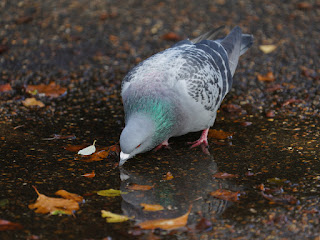It had rained heavily in the night. A Feral Pigeon drank from a puddle.
You can always tell areas where grass seed has been sown as they are instantly thronged with these observant birds eating it.
The wind rose as a Magpie preened its mate in a tree.
Starlings clung on tightly as the gale thrashed the branches.
Cormorants on the posts at the island were having to be very careful about spreading their wings to avoid being blown off.
The Long Water is sheltered by trees and a young Cormorant, still with a juvenile pale front, was having a much easier time.
A young Grey Heron played with a stick on the gravel bank. Perhaps it was rehearsing nesting behaviour.
The Peregrine was back on the tower.
One of the youngest Great Crested Grebe chicks on the Long Water rushed at full tilt to its parent ...
... to collect a fish.
The old rabbit with a blind eye was beside the Henry Moore sculpture. Its condition seems not to have been caused by myxomatosis, as it hasn't got any worse.
The plumbago in the Rose Garden continues to attract insects. I think this hoverfly is a Eupeodes species, maybe luniger, with no common name.
There was also a Common Carder bee ...
... and a Greenbottle fly.
Volunteers had been raking up cut grass on Buck Hill, and got a ride back on the haywain pulled by the splendid Shire horses.












I love draft horses. The more hairy-footed, the better. I have read that the biggest Shire horse in recorded history was called Sampsom and was 2.19 metres high!
ReplyDeleteBest is watching them pull the old mowing machine. It mows very poorly but the spectacle is magnificent.
DeleteA very attractively marked Feral Pigeon at the top.
ReplyDeleteAgree with the hoverfly being a Eupeodes sp. May well be E. luniger but probably need to see the face markings to be sure. On the hoverfly FB page, many are recorded as just Eupeodes sp.
The interesting variety of Feral Pigeon colours tends to be overlooked.
DeleteWill go back over yesterday's hoverfly pictures, but I don't think I got its face.